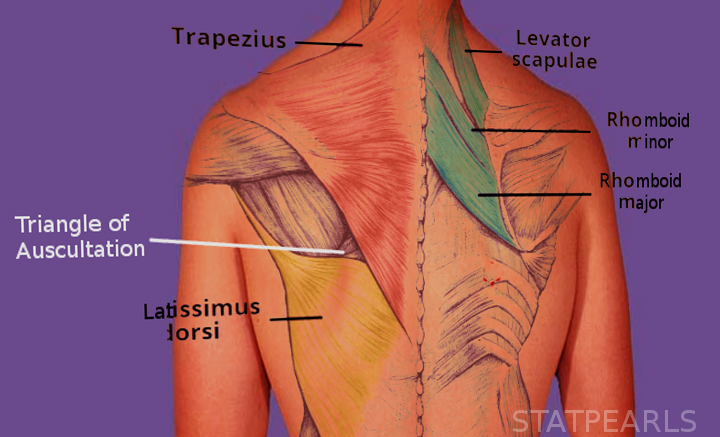[1]
Prakash S, Kalra P, Khan Y, Dhal A. Ventral scapular osteochondroma excision through 'triangle of auscultation': A case series. Journal of orthopaedic surgery (Hong Kong). 2020 Jan-Apr:28(1):2309499019892848. doi: 10.1177/2309499019892848. Epub
[PubMed PMID: 31916491]
Level 2 (mid-level) evidence
[2]
Nazarian J, Down G, Lau OJ. Pleurectomy through the triangle of auscultation for treatment of recurrent pneumothorax in younger patients. Evaluation of 60 consecutive cases. Archives of surgery (Chicago, Ill. : 1960). 1988 Jan:123(1):113-4
[PubMed PMID: 3337648]
Level 3 (low-level) evidence
[3]
DiDio LJ, Yeasting RA. Projection of the triangle of auscultation on the human pulmonary surface. International surgery. 1977 Jun-Jul:62(6-7):338-40
[PubMed PMID: 893009]
[5]
Rankin AJ, Rankin SH, Rankin AC. Auscultating heart and breath sounds through patients' gowns: who does this and does it matter? Postgraduate medical journal. 2015 Jul:91(1077):379-83. doi: 10.1136/postgradmedj-2015-133321. Epub 2015 Jul 16
[PubMed PMID: 26183342]
[6]
Chal J, Pourquié O. Making muscle: skeletal myogenesis in vivo and in vitro. Development (Cambridge, England). 2017 Jun 15:144(12):2104-2122. doi: 10.1242/dev.151035. Epub
[PubMed PMID: 28634270]
[7]
Hernández-Hernández JM, García-González EG, Brun CE, Rudnicki MA. The myogenic regulatory factors, determinants of muscle development, cell identity and regeneration. Seminars in cell & developmental biology. 2017 Dec:72():10-18. doi: 10.1016/j.semcdb.2017.11.010. Epub 2017 Nov 15
[PubMed PMID: 29127045]
[8]
Musumeci G, Castrogiovanni P, Coleman R, Szychlinska MA, Salvatorelli L, Parenti R, Magro G, Imbesi R. Somitogenesis: From somite to skeletal muscle. Acta histochemica. 2015 May-Jun:117(4-5):313-28. doi: 10.1016/j.acthis.2015.02.011. Epub 2015 Apr 4
[PubMed PMID: 25850375]
[9]
Sato T, Koizumi M, Kim JH, Kim JH, Wang BJ, Murakami G, Cho BH. Fetal development of deep back muscles in the human thoracic region with a focus on transversospinalis muscles and the medial branch of the spinal nerve posterior ramus. Journal of anatomy. 2011 Dec:219(6):756-65. doi: 10.1111/j.1469-7580.2011.01430.x. Epub 2011 Sep 29
[PubMed PMID: 21954879]
[10]
Dennis M, Granger A, Ortiz A, Terrell M, Loukos M, Schober J. The anatomy of the musculocutaneous latissimus dorsi flap for neophalloplasty. Clinical anatomy (New York, N.Y.). 2018 Mar:31(2):152-159. doi: 10.1002/ca.23016. Epub 2017 Dec 28
[PubMed PMID: 29178203]
[11]
Yang D, Morris SF. Trapezius muscle: anatomic basis for flap design. Annals of plastic surgery. 1998 Jul:41(1):52-7
[PubMed PMID: 9678469]
[12]
HUELKE DF. The dorsal scapular artery--a proposed term for the artery to the rhomboid muscles. The Anatomical record. 1962 Jan:142():57-61
[PubMed PMID: 14449723]
[13]
Pu YM, Tang EY, Yang XD. Trapezius muscle innervation from the spinal accessory nerve and branches of the cervical plexus. International journal of oral and maxillofacial surgery. 2008 Jun:37(6):567-72. doi: 10.1016/j.ijom.2008.02.002. Epub 2008 Mar 17
[PubMed PMID: 18346876]
[14]
Lee DG, Chang MC. Dorsal scapular nerve injury after trigger point injection into the rhomboid major muscle: A case report. Journal of back and musculoskeletal rehabilitation. 2018 Feb 6:31(1):211-214. doi: 10.3233/BMR-169740. Epub
[PubMed PMID: 28854498]
Level 3 (low-level) evidence
[15]
Camargo PR, Neumann DA. Kinesiologic considerations for targeting activation of scapulothoracic muscles - part 2: trapezius. Brazilian journal of physical therapy. 2019 Nov-Dec:23(6):467-475. doi: 10.1016/j.bjpt.2019.01.011. Epub 2019 Feb 3
[PubMed PMID: 30797676]
[16]
Jung H, Bae J, Kim J, Yoo Y, Lee HJ, Rho H, Han AH, Moon JY. Can the Rhomboid Major Muscle Be Used to Identify the Thoracic Spinal Segment on Ultrasonography? A Prospective Observational Study. Pain medicine (Malden, Mass.). 2022 Sep 30:23(10):1670-1678. doi: 10.1093/pm/pnac043. Epub
[PubMed PMID: 35289904]
Level 2 (mid-level) evidence
[17]
Khan IH, McManus KG, McCraith A, McGuigan JA. Muscle sparing thoracotomy: a biomechanical analysis confirms preservation of muscle strength but no improvement in wound discomfort. European journal of cardio-thoracic surgery : official journal of the European Association for Cardio-thoracic Surgery. 2000 Dec:18(6):656-61
[PubMed PMID: 11113671]
[19]
Ökmen K. Efficacy of rhomboid intercostal block for analgesia after thoracotomy. The Korean journal of pain. 2019 Apr 1:32(2):129-132. doi: 10.3344/kjp.2019.32.2.129. Epub
[PubMed PMID: 31091512]

